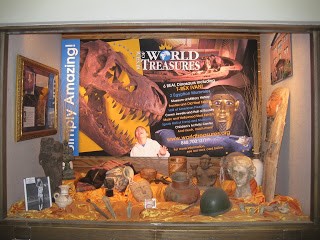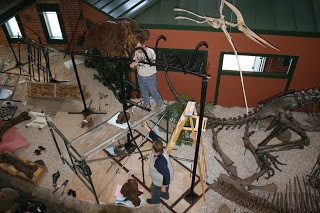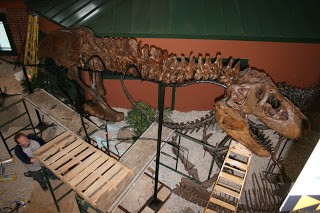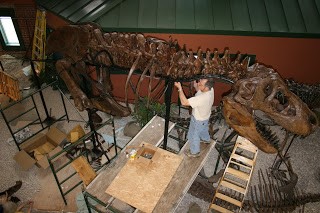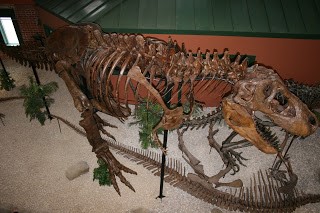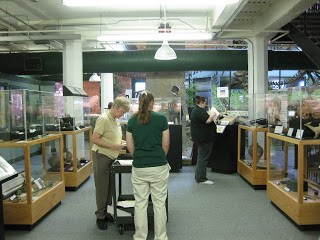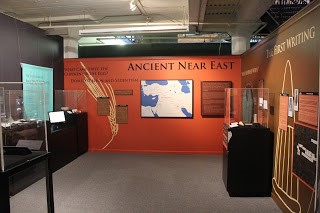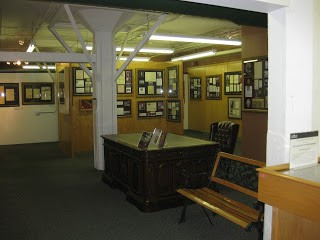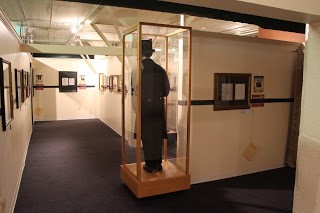History of the Museum Part 2
May 23, 2016
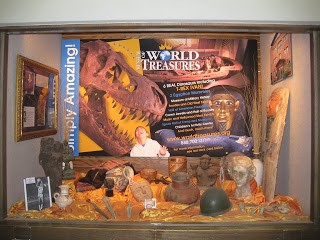
The Museum Gets a New Direction and a New Dinosaur
A lot of the changes that took place in the Museum Of World Treasures (MOWT) up to 2005 were the addition of new artifacts, new exhibits, and the cooperation of new collectors. 2005 marked the beginning of new leadership in the Museum which eventually led to a new direction for the Museum. Up until 2005, Dr. Jon was the President of MOAT and MOWT. In March 2005, the reigns of the Museum were passed to Mike Noller. Mike became the new president and CEO and is still in that role to this day. Mike began changing the focus of the Museum from a collector’s gallery to a modern museum. This shift in focus was a huge task that took a long time to complete. Changing things required crafting a new policy to show why the direction needed to shift.
Mike began to hire museum professionals. Two of these hires were Lon Smith and LaWanda Smith, both of whom came on board as employees in March 2006. Lon Smith became the Director of Sales and Marketing and LaWanda became the Curator of Collections and Exhibits.
LaWanda had the difficult task of compiling all of the information about the artifacts in the Museum into a single, unified record. This involved talking with each of the collectors and trying to find the history of an object. When an artifact is discovered or collected, a record should be made of where it was found, when it was found, and by whom it was found. Every change of ownership should be recorded as well. Modern museums put a very high significance on the history of an object because the interesting stories, the details of the artifact, and the information it can provide are all important.
In 2006, the mission statement changed. As of February 15, 2006, the mission of MOWT became “To provide an innovative, exciting, world-class historical museum that greatly enhances Wichita tourism, educational and cultural opportunities via the collection, [and] preservation and exhibition of rare artifacts from around the world.” The focus of the mission remained the same as it was in the Garvey center: to educate about history. The Museum is built around collections and is focused on tourism. The mission changed again on April 19th, 2007 when it became, “To provide a gateway to the past which educates, entertains, and inspires life-long learning.” In addition to the mission, there was also an accompanying vision, which is “To provide meaningful collection-based learning experiences for the purpose of increasing public awareness and appreciation of our beautifully diverse world.” This mission and vision are still used by the Museum. They set the focus of the Museum on the collection and exhibition of artifacts from around the world.
Lon Smith had a lot of work to do promoting MOWT. He put together a few cases that could be temporarily displayed in local libraries. The Museum staff visited as many as eight libraries, picking up four exhibits, and dropping off four exhibits all in one day. Because it was so labor intensive, the library exhibit program did not last very long. Nevertheless, it was still significant because it promoted the Museum and shared its wealth of artifacts with more people.
In addition to the Library Exhibit program, MOWT was promoted through other outside exhibits as well. Notable among these is the display that was at the Wichita Mid-Continent Airport. A photograph of the exhibit at the airport can be seen in Figure 1. Note that the logo for the Museum has changed. No longer is it a pharaoh mask in front of a pyramid, now it is the name “Museum of World Treasures” with a globe and crown replacing the “o” in “world.” The logo would change again in the future but those would be stylistic changes, rather than complete redesigns.
|
|
|
Figure 1 |
Part of the reason you can tell that the display at the right dates from 2007 is because it makes reference to the biggest thing that has happened to MOWT: Ivan the Tyrannosaurus rex. Ivan was put on display at the Museum on May 12, 2007.
Ivan was discovered in Harding County, South Dakota in July, 2005. He was found by two paleontologists, Gary Olson and Alan Komrosky, who had a business called Hell Creek Relics. Ivan’s skeleton was found on the property of Ivan McGee.
|
|
|
Figure 2 |
While they were excavating and preparing Ivan, Gary and Alan began looking for a buyer. They contacted Dr. Jon, who was still actively collecting artifacts to display in the Museum. In October 2006, Dr. Jon received a recommendation from Dr. Ron Nellermoe at Concordia College. Dr. Nellermoe stated that based on the remains that he had seen, Gary and Alan’s specimen was a genuine Tyrannosaurus skeleton and that it was in very good condition. With confirmation that it would be a good acquisition for the Museum, Dr. Jon went ahead with the acquisition of Ivan.
|
|
|
Figure 3 |
Ivan did not arrive at the Museum all in one piece. Alan and part of his crew arrived at the Museum with the bones, its mount, and the necessary tools to assemble the dinosaur. They began assembling Ivan on May 8 and the construction, which took two days, was open and visible to the public. Figures 2-5 show Ivan during his assembly at the Museum.
|
|
|
Figure 4 |
Not only was Ivan the biggest object ever displayed at the MOWT, he is also the biggest draw that the Museum ever had. In 2007, 57,397 people attended the Museum of World Treasures! There was an extensive media campaign promoting the arrival of Ivan. Ivan has become the Museum’s mascot; appearing on our Christmas cards, postcards, business cards, and signs.
|
|
|
Figure 5 |
Ivan attracted expert Dr. Thomas Carr, Professor of Biology at Carthage College on June 14 and 15, 2007. He came with the intention of seeing Ivan but was also attracted to the other tyrannosaur on display in the Museum. Remember that skeleton that was originally identified as an Albertosaurus? Dr. Carr took one look at it and said that was actually a Daspletosaurus. Daspletosaurus is a tyrannosaur and a close relative of Tyrannosaurus rex. Dr. Carr was familiar with Tyrannosaurus rex and all of the members of its family, so he was definitely in a position to correctly identify our skeleton. He commented that it was a very good specimen and that it was actually very cute. That is how our Daspletosaurus got its nickname, Cutie.
The Museum Improves its Exhibits
With the addition of Ivan, the majority of MOWT’s notable and spectacular artifacts were in its collection and on display. The total number of objects in the Museum in 2007 was around 3,000. By the end of 2015, that number was 9,918. The objects owned by the Museum was around 20% in 2007. By December 2015, that number was 73.93%. LaWanda Smith made it her goal to have more objects donated to the Museum and she gets most of the credit for the improvement of these numbers.
The next big change was actually kind of a loss for MOWT: the Wichita Sports Hall of Fame moved out in 2008. The Hall of Fame had the opportunity to move out on its own. This allowed the space that was once occupied by the Hall of Fame to be converted into the Children’s Activity Center, or CAC. It also allowed the opportunity for the Museum to refocus on history. A smaller sports exhibit remained for a while, using objects owned by, or on loan to, the Museum rather than the Hall of Fame, but it did not have the same draw as the Wichita Sports Hall of Fame.
There were some staff changes that occurred in 2008 as well. First of all, Lon Smith left MOWT in June to become the Director of the Kansas Aviation Museum. He remained a friend of the Museum and worked cooperatively on projects. Second, Danielle Ricklefs was hired as the Director of Education in June 2008. While the Museum always had an education focus, this was the first time someone was hired for the express purpose of education.
Another important hire happened when Amber Javers was hired as the Curator of Exhibits and Research in June 2009. Rather than having exhibits and collections combined in one department, they became two departments.
Amber began a schedule to renovate the existing exhibits. These renovations radically changed the appearance of the Museum. Rather than an exhibit consisting of a series of cases with diverse but related artifacts and minimal signage, it was decided that the exhibits should be developed around themes. The overarching theme would determine what narrative the exhibit would present which would then determine what artifacts would be used in the exhibit. Moreover, standards for signs were put in place so that every object label would be in the same format and every objects was given a label with its object number. These objects labels made it easier for Museum staff to identify objects that were on display and find their associated records and it made it more convenient for guests since every object had a label.
|
|
|
Figure 6 |
The first exhibit to be renovated in the new format was the Ancient Near East exhibit. Figure 6 shows LaWanda Smith, volunteer Jennie Ashton, and Registrar Starrla Bridges preparing to remove the old Mesopotamian exhibit which was to be replaced by Ancient Near East. Notice that there is little consistency, the cases are not uniform, and some are painted black while other have their original wood grain. After the renovation, all the cases were uniform and consistent. A current photograph of Ancient Near East is shown in Figure 7. You can see the inclusion of interactive elements, such as the rotating time wheel and the magnet board. From this point on, every exhibit would include the addition of at least two interactives.
|
|
|
Figure 7 |
Ancient Near East was just the first exhibit to be renovated. Here is a list of all of the exhibits that have been renovated in the past six years: Sea Creatures of the Plains; Founding of America: A Revolutionary Success; World War II: Sharing the Story; Treasures from the Grave: Pre-Hispanic Art and Ritual; Lock, Stock, & Barrel: A Brief Evolution of Firearms and Warfare; Founding of America: Declaration 1843; Romancing the West; Transcend: Religious and Royal Art of Asia; Economics of Empire: Roman Trade, AD 100 – 300; Form and Function: Making a Living in the Cenozoic; Crystallizing Cultures: Geology, Minerals, and Human Civilization; Dawn of the Great War: A World War I Centennial Commemoration; Creating the Crown: Developing Royal Dynasties; Transcribing History: Pictographs, Parchments, and the Printing Press; Through the Lens: Conflict in Vietnam, 1954 - 1975; and Time Adorned: A Highlight of the Museum's Jewelry Collection.
|
|
|
Figure 8 |
Figure 8 shows the President’s Hall from 2010. Figure 9 is a current view of the hall, which is now part of the Founding of America exhibit. The frames in the old exhibit contain historical documents and write-ups about the presidents while in the recent photograph, the documents are in the frames while the write-ups are on separate signs. Separating the signs from the documents makes it easier to alter the signs when they need to be updated.
|
|
|
Figure 9 |
In 2009, MOWT underwent a Museum Assessment Program, or MAP. MAP is a service provided by the American Alliance of Museums (AAM), one of the largest associations of museums. A reviewer visits a museum to assess how well they are meeting AAM standards and to provide feedback on how the museum can improve.
The MAP that MOWT undertook in 2009 focused on the Museum’s organization. The reviewer, Kimberly Camp, suggested that something needed to be done with all of the documents that were on display. The lighting levels were very high, and in many places in the Museum, the documents were actually exposed to natural lighting which could not be controlled at all. These observations prompted the Museum staff to begin making digital copies of its documents and putting facsimiles on display.
Lighting is a concern because light damages documents. All light, regardless of its intensity and/or what type of light it is, can damage paper over time. One way museums can mitigate the harmful effects of light is to control the amount of lighting. When the Founding of America exhibit was completed, all of the documents on display in the Presidents Hall were facsimiles. Currently, there are only four facsimiles in the exhibits whose originals are not in the archives: the Thanksgiving Day Proclamation in Founding of America, the Uncle Sam Recruitment Poster, and the Richard L. Stone Induction Papers in Through the Lens.
“This is the third of four blog entries from guest author Steven King. Stay tuned for the rest in the series."
